Madanjeet Singh UNESCO Goodwill Ambassador and Founder, South Asia Foundation passed away on Sunday the 6th January.
In 1995, the UNESCO-Madanjeet Singh Prize for the Promotion of Tolerance and Non-Violence was initiated to honour his lifelong devotion to communal harmony and peace. The creation of the prize coincided with the 125th anniversary of the birth of Mahatma Gandhi.
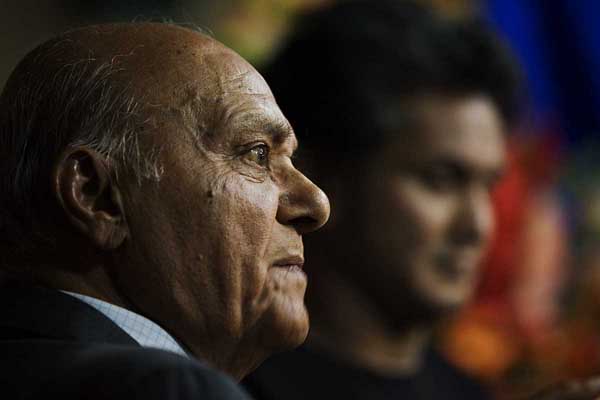
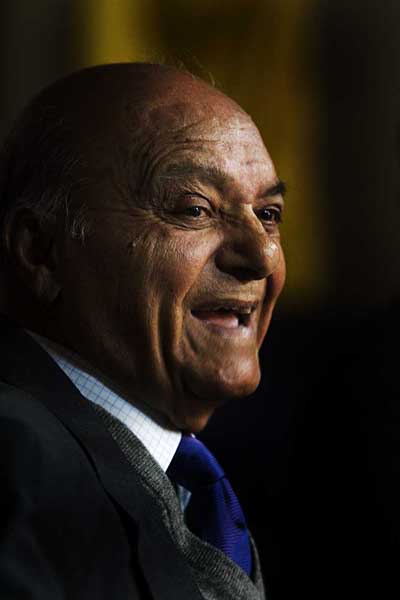
It was on Madanjeet’s invitation that Salma and I had gone to Kashmir. He will be sorely missed
It had been a hectic month. An assignment in Sri Lanka, followed by the World Press Photo award ceremony in Amsterdam and Martin Parr’s Sam Presser lecture. It had been many years since Martin had slept in our flat in Lalmatia, with his feet sticking out of the Bangla sized cane bed. Abir Abdullah a student from the first batch at Pathshala, was there for the launch of the book, “New Stories“. Other WPP students featured in the book, whom I had interacted with over the years Kemal Jufri (Indonesia), Mwanzo Millinga (Tanzania), and Sudharak Olwe (India), had also become established photojournalists. Many of them teachers in their own right.
A trip to Cornwall, for the ‘Majority World Summit‘, with my colleagues Colin Hastings and Rowan Watts followed. Then on to the Nordic Light festival, organised by my old friend Morten Krogvold. Though I had always admired Michael Kenna‘s atmospheric images, this was the first time we met. The Lanky Irishman and I decided we’d bring some mirth into this serious gathering, and swapped our ID tags, confusing everyone. His cousin Gilian Varley, gamely played along. We invented an Aunt Christine, who commented on how dark I’d become. Getting shorter would probably have been more difficult to explain.
Woman with cholera. West Dinajpur. Bangladesh 1971. ? Don McCullin/Contact Press Images
Don McCullin was one of my heroes. We still had his hand-made prints of 1971 in our archives. The long evening chats with Don was a delight. He talked of his experiences in West Dinajpur, and the famous picture of the woman dying of Cholera.
It was comforting to know she had survived. I remember him talking of the exposure reading he had talken before the picture of the grenade being hurled. “Why die for the wrong exposure” he had simply said. William Klein‘s dry wit was as fresh as his photographs.
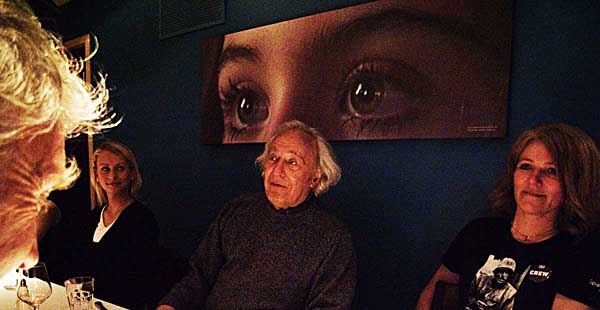
William Klien at Nordic Light Festival. Kristiandund. 2008. ? Shahidul Alam/Drik/Majority World
I was envious of the energy of this octogenarian.
Then it was a pit stop at Heathrow airport to meet up with my sister and pick up my camera equipment before heading off to Tehran for the judging of the First Biennial of Islamic Photography. I had been looking forward to meeting up with James Nachtwey again, but he had to cancel in the last minute and I became the only foreign jury member. My old friend Bahman Jalali was in the Iranian jury. I hadn’t met Shadi Ghadarian since she had visited Chobi Mela III. She and Peyman Hooshmandzadeh now had a beautiful daughter Leila. Staying overnight at their place required all sorts of permission. I was apparently a guest of the president, and the special attention I received, meant limited freedom. I had worked out a system and managed to spend most of my stay at Ruchira Gupta‘s. Ruchira and Sunil took me on the Tehran gallery crawl, plus some interesting diversions like the reception at the magnificent garden of the Italian Ambassador, and the studio of the rebel artist Parvaneh Etemadi. Omid Salehi, the other Iranian photographer who had come to Bangladesh for Chobi Mela III, made it back in time from Kurdistan to my lecture at Saba, so it was a reunion of sorts.
I briefly returning to Dhaka before going to Mumbai for the finals of the Development Marketplace contest. Shabana Azmi, who was giving away the prizes was a friend of Parveneh and Ruchira, so we stole a few minutes on stage to talk of old friends. I was also able to meet up with old friends David and Charmayne De Souza, Swapan Mukherjee, Fawzan Hossain and Suchit and Annu Nanda. Another pit stop in Dhaka and then the trip I’d been waiting for. Madanjeet Singh‘s invitation to Srinagar in Kashmir.
It wasn’t the celebrity group that Madanjeet had invited that attracted me. Srinagar was a place I had longed to see. It wasn’t so much the beauty of Kashmir, or the Shalimar Gardens that intrigued me. I had photographed the earthquake in the Pakistani section of Kashmir. Knowing the relevance of the region to peace in South Asia, I wanted to find out for myself, what the Kashmiris felt. With Indian visas becoming increasingly more difficult to get, this was a chance I was not going to waste.
The former foreign secretary Farooq Sobhan had been a bridge partner when we were both playing in the Dhaka Club Blue team. We were then national champions, representing Bangladesh. Jamilur Reza Chowdhury had been part of our small group of people who had been active in trying to get Internet to Bangladesh. We were the three Bangladeshis in this gathering of South Asians. Photographer Ram Rahman and activist Harsh Kapoor were old friends, but there were the quirky incidents with people I knew less well, that livened up my stay. Like the midnight meeting with Chandrika Kumaratunga in the business centre of the Grand Palace.

Former president of Sri Lanka Chandrika Kumaratunga at business centre of Grand Palace Hotel in Srinagar. Kashmir. India. 2008. ? Shahidul Alam/Drik/Majority World
While I helped her get connected to the Net, I remembered how elusive she had been when I had wanted to photographer her while she was president of Sri Lanka.
But the tension outside was difficult to ignore. Few Kashmiris would say anything out of place. At least at first encounter. But from the security checks before boarding the plane, the police registration upon arrival at Srinagar airport, the inability to use our mobile phones, the multiple layer check posts on the way to the hotel and the embargos on either leaving early or arriving late, one knew things were not Okay.
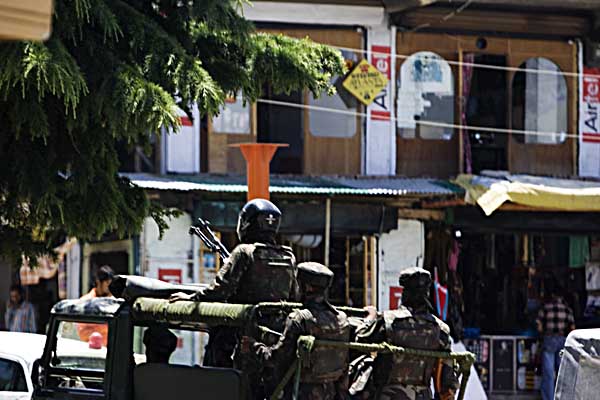
Military patrol in streets of Srinagar. Kashmir. India. 2008. 2008. ? Shahidul Alam/Drik/Majority World
On our trip to Uri, the one trip we made out of Srinagar, the visual signs of Indian military presence was overwhelming. The convoys of military vehicles moving in both directions.
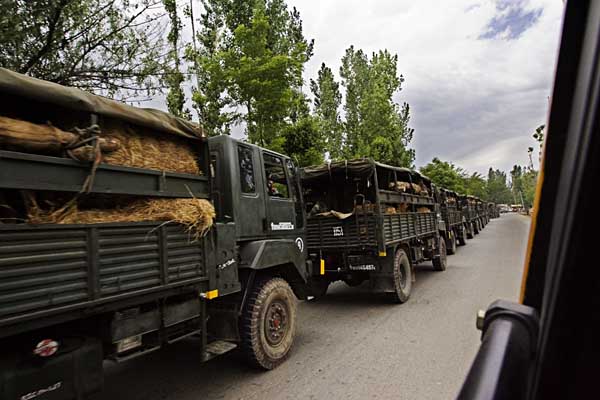
Military convoy on the road to Uri. Srinagar. Kashmir. India. 2008. 2008. ? Shahidul Alam/Drik/Majority World


Soldiers in Paradise. Uri. Kashmir. India. 2008. 2008. ? Shahidul Alam/Drik/Majority World
The enormous security team that chaperoned us through the city. The nervours soldiers near the line of control. All had the visible signs of occupation.
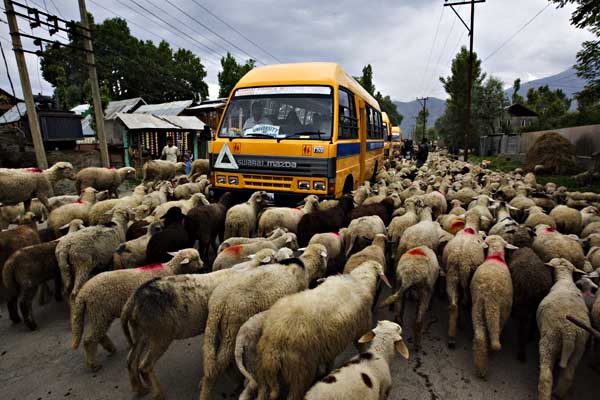
Sheep claim the right of way. Road to Uri. Kashmir. India. 2008. 2008. ? Shahidul Alam/Drik/Majority World
There had been relative peace in Kashmir, and the economy had prospered during the lull in violence. The concert in Srinagar, by the Pakistani group Junoon, while enjoyed by the young crowd that attended, was criticised by others. Kashmir was far from unified, and opinions about the role of the Indian military and the role of the Kashmiri militants differed, but once you went below the surface, once there was a modicum of trust, they all spoke of one desire. Azadi (freedom).
Salma Ali was one of the new people I met. Quiet but determined, she tried to talk me into going with her to see the Pashmini weavers. I didn’t need much persuading.

New Indian Aeroplane. The shikara which took me across Dal Lake. Srinagar. Kashmir. India. 2008. 2008. ? Shahidul Alam/Drik/Majority World
I had been told off for going on a Shikara (wooden boat) trip on my own. We decided to ignore the restrictions on early morning departures and went for a dawn Shikara ride. The boatmen never came, and apart from the pictures I took of the boats gliding through the mist,
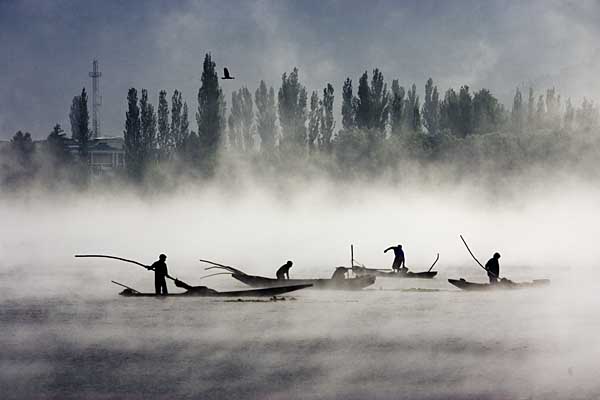
Boatmen in Dal Lake clearing weeds early in the morning. Srinagar. Kashmir. India. 2008. 2008. ? Shahidul Alam/Drik/Majority World
or the friendly Kingfisher that perched nearby, I spent much of that morning talking to my new found friend. She had seen a different Kashmir. The following is Salma’s story.
Paradise Found
By Salma Hasan Ali
The Mughal Emperor Jahangir is said to have written about Kashmir, “Gar firdous bar rue zamin ast hamin ast, hamin ast, hamin ast” (If there is paradise on earth, it is here, it is here, it is here.)
My first morning in Kashmir, I was awoken by a gentle, sorrowful sound. Thinking I was in a dreamlike stage between jetlag from a 20-hour journey and the excitement of coming to a place I never thought I would see in my lifetime, I tried to go back to sleep.
I couldn’t. It was 4:15 am, and the sound beckoned — softly, longingly, mournfully. I sat up in bed and gazed out the window, letting my eyes wander to the direction of the sound — behind the mountains to the east, beyond the Lake, between the mist and the darkness. It continued its lament, its gentle pleading. I opened the door to the veranda to listen more intently, wrapping myself in my shawl for warmth and protection. The song continued. It was in Arabic, perhaps verses from the Quran, I thought. But what? And why? I closed my eyes and listened. It seemed like the mountains, the lake, they were praying. Perhaps remembering times past, when heaven needed no protection; perhaps asking for forgiveness from all the misery they had witnessed. Everything was still, attentive — the chinars, the roses, the birds, the wind. It seemed they were listening too, and agreeing. The lament continued until the darkness turned to day, and then, as mysteriously as it had started, it quieted. I never heard it again. It’s safer to cry in the dark, when no one can see your vulnerability; to pray in the still of the night, so the day can wash away the pain.
Lady Mohini Noon introduced me to Mehraj bhai as soon as I arrived in Srinagar. Mohini and I happened to share a car together from the airport to the Grand Palace hotel, and our first get-to-know-you conversation somehow turned to shawls. She said her shawl-wala, from whom she has been buying shawls for more than 20 years (and her mother from his father before that) lives in Srinagar, and usually travels to Delhi to visit her when she is there. I thought to myself how amazing it would be to meet Mehraj and see his shawl collection. As if reading my mind, Mohini called Mehraj as soon as we arrived at the hotel. A few hours later, having secured special permission for him to enter the hotel gates given the tight security in the city during our stay, there he was with bundles and bundles of shawls, in every variety and color and texture, all wrapped up in cotton sheets. I was in heaven, in every sense of the word. I have been collecting shawls for years, from all corners of the world, and now to be in the birthplace of shawls, with shawl after glorious shawl being unwrapped in front of me, was a dream come true. We spent hours modeling pashminas and jamawars and kanis. But there was one in particular I just couldn’t take my eyes away from.

Salma in her new shawl. Grand Palace Hotel. Srinagar. Kashmir. India. 2008. 2008. ? Shahidul Alam/Drik/Majority World
I had asked Mehraj if he would take me to the place where these shawls are made and teach me about the process, an age-old tradition which fewer and fewer practice. We planned to meet the next morning at 9:30 am. I was getting cold feet. Where would Mehraj take me, would I be able to get back to the hotel given the bund in the city that day, and in time for the afternoon events, and what about all the warnings from family not to wander off foolishly by myself. Determined to go, I decided to ask a fellow event participant to join me. He had a silver-gray tussle of a beard, and despite his gentle eyes, I thought he would suffice as a bodyguard — and he had a very fancy camera around his neck — perfect, he would take great pictures too, I thought. He graciously agreed and we were off to the Old City in Mehraj’s little white Toyota Innova. Little did I know then that I had just invited one of the world’s most renowned photojournalists to accompany me on my shawl jaunt.
We arrived in a narrow dirt lane outside a multi-storied brown-brick building where Mehraj used to live (his sister and her family live there now) which serves as shawl-making central. We walked up the narrow winding staircase to a small windowed room painted in blue with three hand looms. Gilam Mohammad, in a checkered shirt, was working on the loom to the right as we entered. He has been weaving shawls for 20 years. Shaukat Ahmad, in the dark striped shirt, had been doing this work for over 13 years. When I asked Shaukat if he enjoyed what he does, he hesitated but said, “I like this work, that’s why I do it.” When I asked him if he would want his children to learn his craft and continue the family tradition, he was more unwavering: “My hope is that my children do something else, hopefully they will get a government job. Someone is going to learn this craft after me, but not my kids,” he added. Shaukat and Gilam work at the looms eight to nine hours each day, their poor eyesight testament to their many hours of meticulous work. Asked how they feel about the fact that this tradition is no longer as prized as it once was, Mehraj Bhai quickly added, “I feel sad that so many countries are now making shawls by machine; that people are being cheated of quality and workmanship.”
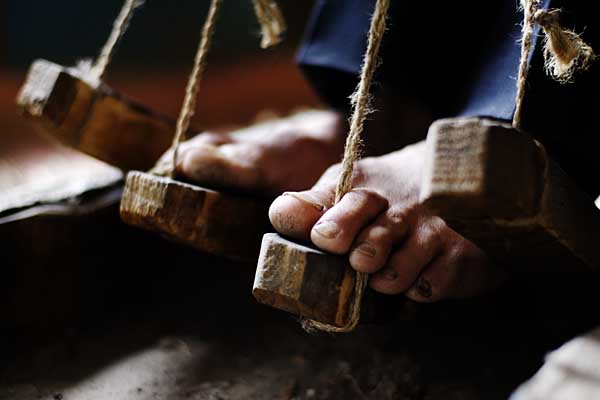
Pedals of the looms used for weaving Pashmina. Srinagar. Kashmir. India. 2008. 2008. ? Shahidul Alam/Drik/Majority World
We walked around the corner to another home where two women, mother and daughter, were chatting and working. Mehraj bhai handed me a plastic bag of wool.
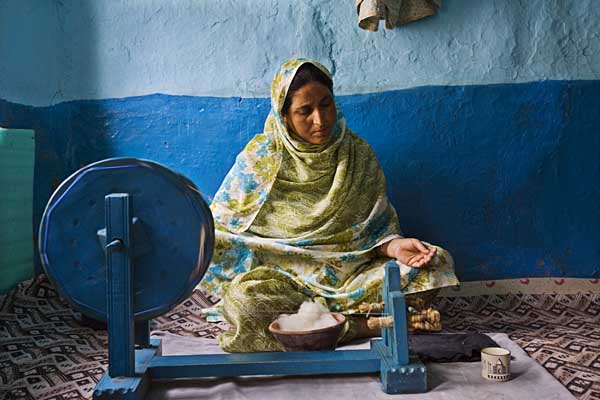
Woman with spindle. Srinagar. Kashmir. India. 2008. 2008. ? Shahidul Alam/Drik/Majority World
The mother, Muglee, wearing a floral colored shalwar kameez and sitting against the wall with one leg outstretched, showed me how to clean the wool, to remove the soft hair from the coarse. Lovly, her daughter was spinning the wool into yarn on the charkha — painted blue to match the blue walls behind her. Wearing a black abaya, her head gently covered by a matching dupatta, she smiled as she worked, patiently showing me how to hold the wool, oh so gently, with one hand so it doesn’t break. It did, each time I tried. Lovly’s two children played around them, her daughter smiling constantly like her mom.
She kept holding out her hand so I would be sure to see the round circle of mehndi on her palm; her son was captivated with Shahidul’s camera. Shahidul took his picture and showed him his image on the screen.
In the next house, we met Muglee Bhat and her daughter Rushna. Muglee thought she was about 50. We couldn’t take our eyes off her. Her gentle smile, her graceful manner, her elegant features, and those eyes. Captivating. She didn’t quite understand why we kept taking her picture. And her daughter’s too. No one had ever taken a photo of them before. They saw themselves captured in pixels for the first time in Shahidul’s lens.
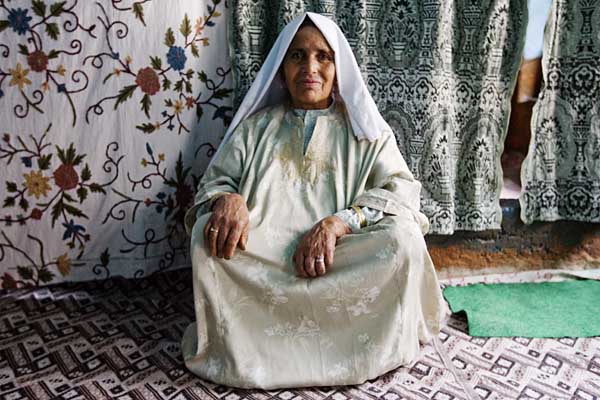
Mughlee Bhat being photographed for the first time. Srinagar. Kashmir. India. 2008. 2008. ? Shahidul Alam/Drik/Majority World
Then we met Zahoor, the man who had woven the shawl that had captured my eye the day before. He was working on another one that seemed similar — with 200 tillis wrapped in different colored yarn splayed in front of him, following a numbered pattern on a piece of paper that was perched on the loom like a sheet of music.

Tillis used for weaving Pashmina. Srinagar. Kashmir. India. 2008. 2008. ? Shahidul Alam/Drik/Majority World
He had completed 20 inches so far. In seven months. The shawl I had fallen in love had taken him thirty months to make.
It was my last day in Kashmir and I hadn’t yet been on a shikara ride on Dal Lake. Shahidul and I decided to go early, when the light would be just right. We walked outside our hotel and waited by the edge of the lake, where two shikaras were moored. Shahidul started stalking a kingfisher.
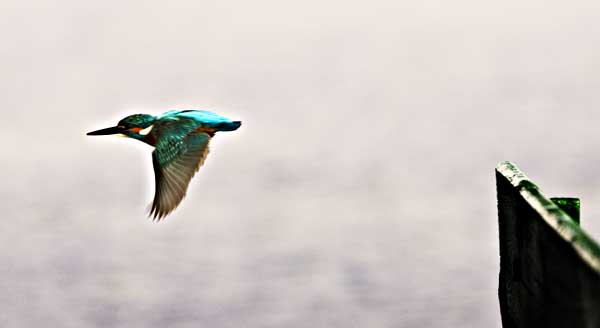
Kingfisher at Dal Lake. Srinagar. Kashmir. India. 2008. 2008. ? Shahidul Alam/Drik/Majority World
The kingfisher played hard to get. He persisted, tiptoeing closer and closer to capture the birds best side. Soon, it seemed the kingfisher was enjoying all the fuss. He started posing, turning this way and that. Even leaping into the lake to show off his fish-catching prowess. As we waited for the shikara drivers to arrive, we called out to the boatmen in the distance who started appearing, like ghosts, from behind the mist. “Bhai, hum ko be jana hai,” Shahidul yelled out, hoping they would take us along. “Thorey dher ke liya, aajao.” They didn’t oblige. We didn’t get to ride in a shikara that day, but it didn’t matter. With the mist gently rising from the lake and inching its way up the mountains, the graceful silhouette of boatmen tirelessly cleaning the lake, houseboats lazily lolling on the placid waters, majestic mountains protecting its dignity — we knew we had found what we had come for … it is here, it is here, it is here.

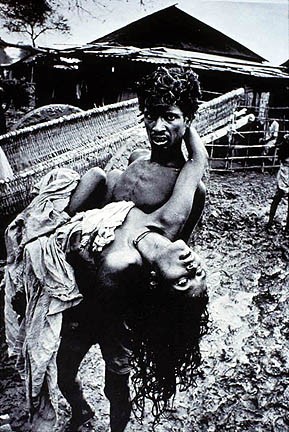
Any story on Kashmir and Kasmiri people flashes in my mind the picture story on Kashmir done by Zishaan Akbar Latif, a photographer based in Kashmir.He dubbed Kashmir as a place of bunkers .The name of the story itself reveals how the Kashmiris in general are in a state of discomfort.
The text and the image link is as in below.
Suvendu
In 1947 Kashmir has been a torn space in the middle of two proud nations:India and Pakistan.
The Indian government has set up bunkers throughout Kashmir as a way to combat insurgency since 1989.
Most bunkers are located in the city of Srinagar.
A bunker is a defensive military fortification.
Bunkers are built of bricks,sand bags,stone and wood,most are permanent.Some are mobile continually changing their location.
The walls of bunkers protect India’s soldiers from revolt in Kashmir as they monitor aggressive activity from within.
Although the structures are supposed to provide safety to the Valley’s locals,Bunkers are a source of tension.They instill fear in the people.
Bunkers are etched into the landscape.All reiterate the presence of conflict in the Valley of Kashmir.
Around the world Srinagar is dubbed as the City of Bunkers. For the past 19 years the local residents of Srinagar have lived with bunkers on top of their houses,on side walks,outside schools,colleges,hospitals,hence they have become a part of their daily life. This document of bunkers is from the local perspective and how the presence of bunkers does not stop them from living. Jammu and Kashmir.
Zishaan Latif
www,zishaanlatif.com
Simply captivating – stimulating emotions of ecstatic joy, forlorn sadness, childlike bewilderment, an unknowing sense of anxiety and so much more. You share your soul enriching experiences as you travel with such depth Shahidul that all of us who will read it cannot but feel a part of it and see through your eyes the awesome beauty of the ‘here ‘ you talk about – you take us through it – holding hands.
Thank you
Runi
I would request the reader to also go through a piece on Kashmir,a personal account,a heart felt account after a month spent in a land so unusual and so unique that it bleeds to be heard!
http://viiphoto.ning.com/profiles/blog/show?id=907146%3ABlogPost%3A22746
Thank you,
Zishaan Akbar Latif
One of the most solemn and intriguing pieces I have ever read. I thought I was just reading the precise and detail prose of someone like Amitabh Ghosh.
Thank you for the piece.
Despite his hectic globe-trotting that Shahidul has added to his enviable store of skills, the one that I cherish most besides his sublime photography and his multifarious investments in its tireless promotion as art world-wide,is his pictorial writing that enthralls me no end. It beguiles and soars.
I wish we all had his kind of eyes to see Kashmir the way he did, capturing its munificent beauty under siege, its body fractured, its soul singed.
This piece lit up my memoryscape with faces of friends: Ram Rehman (we hosted his exhibition of Ayodhya Thru Ages, in south California years ago), and Ruchira Gupta (who had confronted L.K.Advani in Ayodhya).
As to his flash of gallantry vis-a-vis Chandrika Kumaratunga, I will “compliment” him in my own way, only when we meet in person.
Shahidul,
Thank you. A joy to read and to see.
Great piece Sahidul !… It quitely drifted my senses to those few ecstatic days that i shared with the valley of Kashmir way back in 1989. Your photographs are so live – they talk much more than show. Keep it up. I enjoyed reading the piece.
MK singh
Dear Shahidul bhai,
Thanks for the lovely story accompanied by lovely pictures – of the place which is now more illusive than heaven itself for most of us. Your “Meraj sharif” to the valley of Kashmir was my vehicle(flying horse?)of imagination to the place on earth where nature appears in its best. Didn’t someone say, “Ye Jannat ka Nazara hai” (the specifimen of heaven)?
Along with a bunch of Dhaka University boys and girls we made a “study tour” of Kashmir in the Autumn of 1980. In those days the sights of the groaning army convoys was not rare though, we had unfettered access to places far and near. We freely mixed with people and talked about almost anything. We asked all sorts of naive questions including what if it became part of Pakistan – under the watchful eyes of a Indira Gandhi piture? In one house, we even found a Jinnah picture peacefully standing side by side with Nehru’s. But we were corrected, it was of Sheikh Abdullah, not Jinnah. We came away with the feeling then that conflict over Ksahmir was not the problem of the people living there – it was essentially a political problem between the two countries. Local people had complaints against their government (Indian)who chose to focus more on military than local development. Kashmir was then indeed remote and underdeveloped – it is now more so, I suppose. We don’t remember having heard of human rights abuse then.
Bangladesh, to most of them was like a country in another planet, although Bengali tourists (mainly from West Bengal)were quite familiar. Basing ourselves in a Bengali Hotel in Srinagar, we made trips away into brilliant mountanous places like Gulmarg, Sonemarg etc. Spent some of the most brilliantly relaxing hours of life on the serene waters of Dal Lake on board Shikara boats….
When shall we get another chance (if ever) to behold the majestic beauty of Kashmir? Will our children get to see it before they are in their “true” heavens? Your pictures dare us dream of that time!
Taher.
Have read much on this ravaged and tension filled area, but this story tugs at the heart strings. And the photography that goes with it brings tears to the eye.
Focussing on, on one hand beauty that makes you gasp with joy. On the other, the fear and misery. Living hell in Paradise.
Thank you, the both of you, for this very moving experience.
Nighat Mir
Karachi
Pakistan
Very very beautiful and deeply moving.
yah it consists of real and facts things the picture of kashmir you have drawn is really nice but now it is not as charming as it was just like said by Jahangir if heaven is anywhere it is only in kashmir but after this terrorist movement is is not like that. the natural creaters are same but the people who face so many hardship and miseries are not same as they were. because there is reason behind that their unforgetable days their sorrows and their painful life
You’re amazing. Keep up the great job. I really appreciate the information. Thank you so much for the wonderful content you have created! I admire you. I really enjoy it! Your report feels like an A. Your artical is great! I have been to your posts before. Great post. Your artical is great! After read it, I think a lot. The content is very exciting and I can almost understand. Please keep going on and continue to add excellent posts. That’s big help for me. You are tops.Great! You have done a terrific job communicating your message. I totally agree with your opinion. Thanks! Your atical is really surprising.The article is very helpful to me. The more I read, the more I keep coming back!